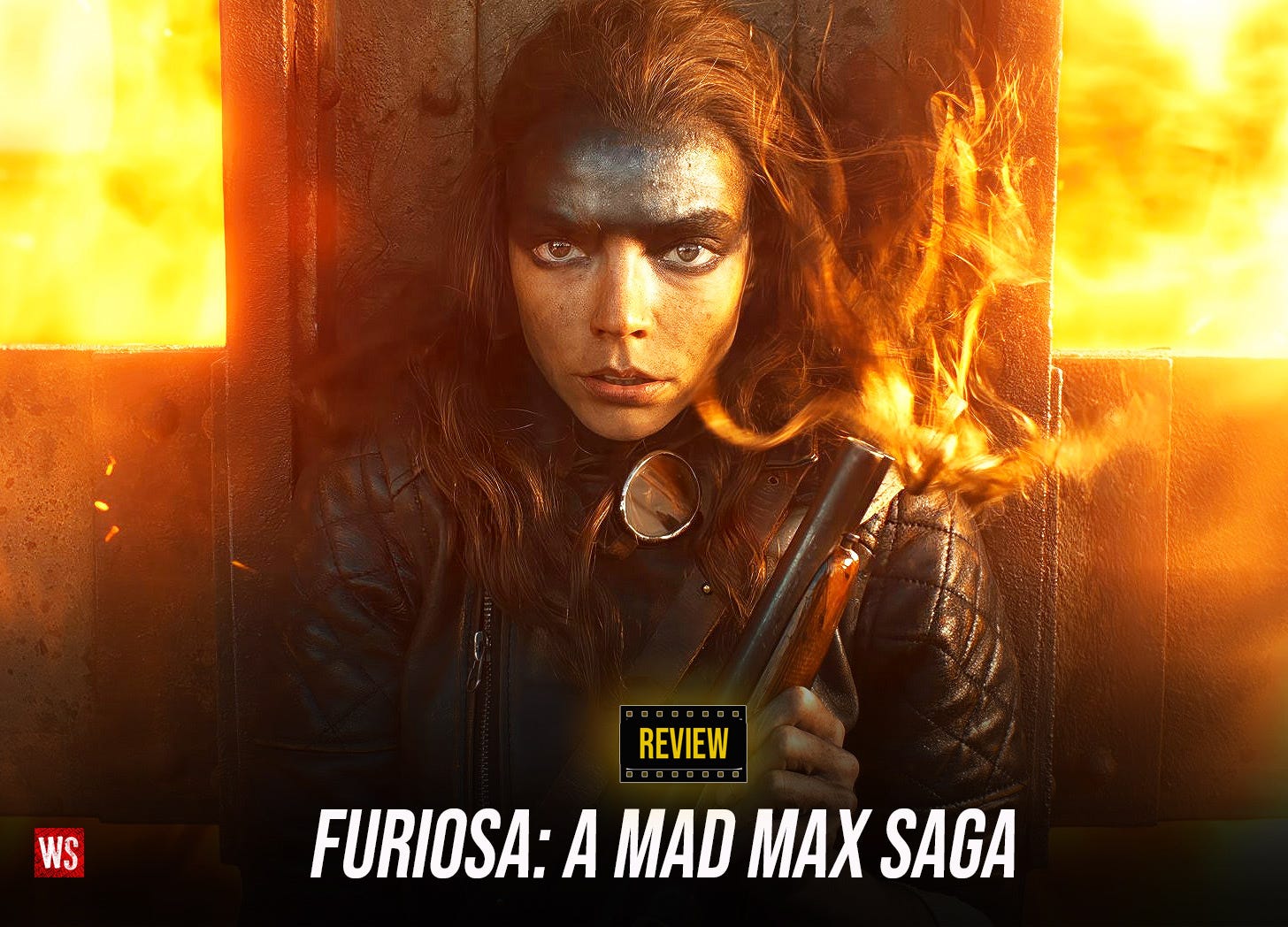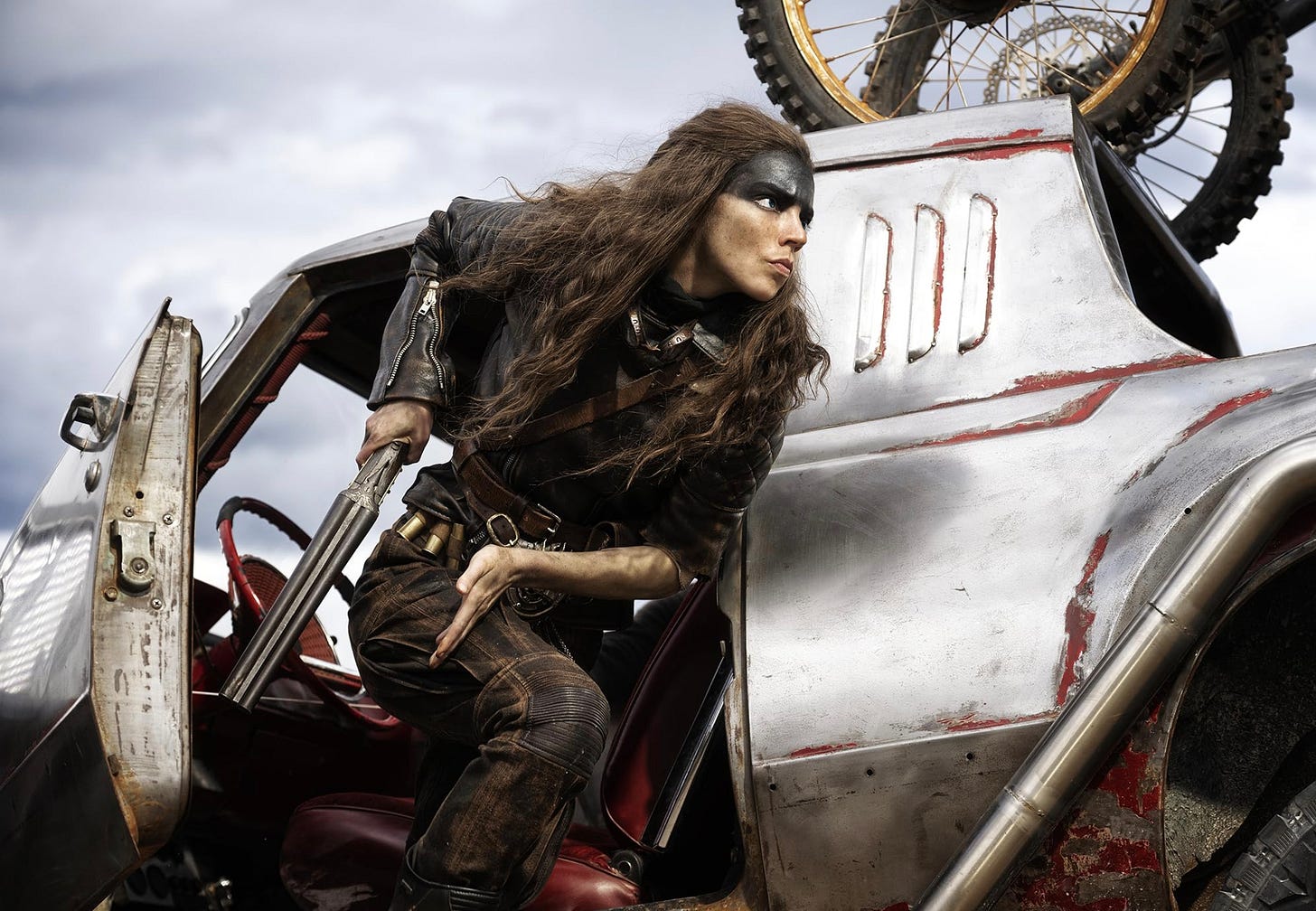Review: Furiosa
George Miller's Mad Max prequel takes a different, but still epic (fury) road
If you’re a first-time reader (or even a repeat one), please make sure to subscribe, be it free or paid, to this Substack. Both help tremendously in supporting my work and I’m forever grateful to all that do.
The first mistake you can make with Furiosa: A Mad Max Saga, is expecting it to be just like Mad Max: Fury Road. The second mistake you can make is not going to see Furiosa for that reason. While Fury Road sets a standard that’s impossible to topple, Furiosa is no less a tremendously vibrant, exhaustingly cool, and mythology-building entry into the franchise that capitalizes on the vision and style blueprint that George Miller has created for his post-apocalyptic wasteland.
Writer/Director George Miller has been revisiting and refining this vision since 1979’s hallmark, Mad Max, taking audiences on an ever-evolving tale of a post-apocalyptic future in which savage survival is the name of the game, while humanity struggled to, well, be human. The first three entries in Miller’s Mad Max saga starred Mel Gibson, who embodied the silent road warrior with his charismatic stoicism and grit, reaching the end of his journey with the franchise in Mad Max: Beyond Thunderdome, an underwhelming entry that debuted in 1985, co-directed with George Ogilvie and amounting to a more diluted effort that was missing Miller’s rigorous vision.
It took 30 years for Miller to return to the saga, and in most cases, you’d expect the long delay to equal a ‘mediocre’ film, but that wasn’t the case. Like, at all. 2015’s Mad Max: Fury Road took the box office by storm, particularly for the Mad Max saga, and took home six Oscars for its trouble to boot. Fury Road saw Tom Hardy replacing Gibson as Max, while introducing Charlize Theron as Imperator Furiosa, a war rig driver for the despotic Immortan Joe, played by the late Hugh Keays-Byrne. Fury Road has since been included on many of the ‘definitive’ best-of lists, and stands as a technical marvel of epic proportions, capturing some of the best in-camera, practical action that’s ever been put on film. It also catapulted Theron’s Furiosa as a newly-beloved character in the Mad Max mythology.
Enter Furiosa: A Mad Max Saga, Miller’s first-ever prequel set within the Mad Max wasteland world that focuses on a character other than Max. Recasting Furiosa with Anya Taylor-Joy in place of Theron (to not distract audiences with de-aging technology, according to Miller), as well as Lachy Hulme taking over Keays-Byrne’s Immortan Joe, Furiosa also has many of Fury Road’s side characters returning with original actors, including John Howard as The People Eater, Nathan Jones as Rictus Erectus, and Angus Sampson as The Organic Mechanic.
Sharp-eyed viewers will also note that Josh Helman, who played Slit in Fury Road, is back in a new role as the Beavis and Butthead-looking Scrotus. The two new major additions to the cast in terms of characters are Chris Hemsworth, taking on the main heavy role as Dr. Dementus, and Tom Burke as Pratorian Jack, a mentor-like role for Furiosa and the original driver of Immortan Joe’s war rig. Also back are much of the Oscar-winning crew of Fury Road, including editor Margaret Sixel and composer Tom Holkenborg, making for a near-perfect concoction of talent to brew the latest Mad Max saga.
So, let’s not make any bones about it. Furiosa is not Fury Road. Nor should it be. The absolute worst thing Miller could’ve done would’ve been to rehash the brilliance of the previous film and repackage it into a new one. Instead, Miller leans deep into the mythology, lore, and characters, giving the most sprawling look into the epic scope of the wasteland to date. Seeing more nooks and crannies of The Citadel, as well as a first look at both The Bullet Farm and Gas Town, we finally get to look under the hood of these varied post-apocalyptic ecosystems and how they work. It’s not all that complex, but it’s still a more intricate look at the how and why of these tribal leaders and tyrants who control the burned-out future.
Whereas Fury Road was essentially a long chase movie that drives in one direction and then turns around to drive back, Furiosa is a time-spanning tale of revenge, survival, pain, love, and betrayal. You could toss in a bunch of themes to encapsulate Furiosa, as it is essentially a human story, set amongst the dismal wreckage of a war-torn world, painted with colorful, grotesque, violent, and destitute survivors trying to make their way in a hopeless existence.
One warning for Furiosa viewers is that it is broken into five different chapters, each of them spaced out a few years, beginning with Furiosa as a child, played by actress Alyla Browne, who appears as the titular character for the first hour. While top-billed, Taylor-Joy doesn’t show up until about the halfway point of Furiosa, which makes perfect sense within the bounds of the story Miller is telling. The questions about the green place, what happened to Furiosa’s mother, and how she came to become what she became are all answered, but it’s not all on Taylor-Joy’s shoulders to embody.
Thankfully, Taylor-Joy (as well as Brown for her part in the story) is up to the task of playing the role that Theron defined. She makes Furiosa her own while honoring the tracks laid by Theron. Most of her work is done physically or emotionally, but not with dialogue. Like Max Rockatansky, she is a character of few words, but many deeds, chief of which is avenging her mother’s death at the hands of Hemsworth’s Dementus. Hemsworth, an actor who has leaned heavily into mostly heroic roles (with some villainous deviations in Spiderhead, Bad Times At The El Royale, A Perfect Getaway), his performance as Dementus is certainly larger than life, although not always as grandiose as he may have hoped.
Dementus is a villain, but he’s also a survivor, a point that sneaks around the corner from time to time, making you wonder if there’s some shred of redemption for him (yeah, not really). He’s not a great leader, nor a smart one, but he makes up for it in brutality and charisma with mixed results. Wielding a prosthetic nose isn’t enough to completely change the muscular actor (who still manages to wear a red cape at one point) into a wasteland baddie, so he adopts a nasally native accent that works well enough for the persona of Dementus, but is no less grating at times. Sure, we hate him as a villain and can even relate to him a bit as such, but a little more intensity over antics would’ve gone a long way. Still, Hemsworth is a good get for the main villain and gives his all to the role, even if it’s not always on target.
What most people will flock to Furiosa for is the action, fortunately, or unfortunately because of what was done in Fury Road. Some will feel satiated and some will feel lacking in that department, which will vary with each individual and how well they can separate the two films (while also connecting them). The good news is that Miller is still at the top of his game when it comes to practical and VFX action, making what could’ve been a CGI nightmare into a fever dream of spectacular stunts and brutality that remains unmatched by most modern filmmakers. Miller, whether you love or hate Furiosa, gives a masterclass in directing craftsmanship with Furiosa, as he did with Fury Road. Where you fall in terms of which is better relies entirely on your personal preferences, but both fall well in line with one another, making for a majestic double feature that I can’t wait to enjoy down the line.
Tom Holkenborg’s score is also well in line with Fury Road’s propulsive soundtrack, giving a more anxious, harrowing score to Furiosa than the steadily-paced heroic one of Fury Road, with both colliding exactly where they should in terms of a consistent flow between films. As a composer, Holkenborg can sometimes come off as just doing a job, while other times coming off like he melted down his heart and soul and poured it into the work like flowing lava. Furiosa lets the lava flow.
If I have any kind of complaint about Furiosa, it’s the lack of blood and gore. It’s an R-rated movie and it certainly doesn’t pull any punches in terms of brutality, violence, and post-apocalyptic deformities, but frequently the level of intensity didn’t match the level of gore it should have. I’m not looking for gore porn here, to be clear, but there were a few too many times that the camera cut away or avoided some of the violence portrayed that could’ve used that extra gut punch to drive home not only Furiosa’s thirst for revenge, but the bloody consequences of living in such a time and under such circumstances. It’s a minor complaint, but there were just too many times that I questioned whether this was a hard PG-13 or a weak R.
While the narrative structure, tone, and vibe of Furiosa is very different than Fury Road, it is no less a riotous and bombastic affair that allows the characters to breathe a bit more between chapters. The action, vision, and style of Fury Road is ever-present but packaged for a very different story. For me, that’s a great measure to have, be it a prequel or a sequel. It harkens back to what we want, while also giving us something new, making the journey that much more interesting to invest in, rather than just jumping back on the same rollercoaster we just rode.
I think most audiences will, at a minimum, enjoy the Fury Road similarities of Furiosa, while lamenting the differences. Others will surely rally to a call of Furiosa being better than Fury Road, causing strife amongst cinephiles that will surely rage stupidly on X. The fact that an argument can be had says a lot about both films when it comes down to it.
Fury Road is no doubt an unbeatable classic, but Furiosa is damned perfect as a lead-in/origin story to it. It clips all the branches and hits all the notes one could want from a prequel. It doesn’t need to compete with Fury Road, it just needs to exist alongside it, perfectly on pace with Miller’s vision. For my money, I’m just grateful to have another epic entry in this blossoming saga under Miller’s sure hand, which has left me even hungrier for a sequel that involves both Max and Furiosa, completing a new wasteland trilogy for the ages. While no hope exists in Miller’s post-apocalyptic world, Furiosa proves there is hope to spare in his signature franchise.










